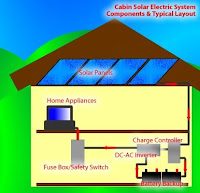
Friday, September 12, 2008
The Solar Home In Action

Natural-Bio-Gas Combination


Methane ( Natural gas-Bio-gas or Wood- gas ) powered motor driven alternator is a unique way to disperse organic waste. Twenty pounds of dry matter which consists of dry leaves, vegetable scraps, straw, and activated sludge will yield 250 cubic feet of biogas. This gas can be used to run engines, cook, light, refrigerate, boil water, etc. The gas produced when sludge is piped underground to a storage digester for on demand fuel use when needed. Personal use patterns illustrate the consumption rate per hour with various burn tasks. A 1 horsepower stuart engine will consume 18 cubic feet biogas per hour coupled with a 2000 Watts D.C. 110 volt generator. The generator will produce 1860 Watts while running on biogas. The generator set on automatic demand during high human use pattern periods. Generator peak demand back up with human use patterns for all seasons, aswell a natural gas converter system on the average car will allow this system to refuel hybrid automobiles at the local household station.
Wind Energy and Electric/Solar/ Hybrid Car Power


1000 WATT wind charger will begin charging batteries with a 8 mph breeze or a wind machine can also pump water directly. Wind power comes in many variations such as wind speed, direction, temperature, height, gusty, or smooth. This of course changes with the seasons making wind energy hard to predict but mostly is blowing during seasonal changes. Some wind sites have a prevailing wind that is fairly constant year round.
Secondary vehicle isolator battery charging systems are used year round for storing excess electricity while commuting. The energy is transferred to dwelling by means of a special connector in garage area. The device will not drain cranking or drive battery system. Energy is on demand during high load hours in sequence with at home use patterns as well illustrates the storage amount saved in ampere hours needed during a up coming trip or daily commute milage range.
Every 50 miles driven in a average solar hybrid/electric car can supply approximately 120 ampere hour to the extra storage cell battery on board.
Water and Small Hydro-Electric Combination

1000 WATT Hydro-electric generator is dependent on the flow of water through the site or heavy rainfall in the guttering system. The amount of water falling is measured in gallons per minute or running pounds of pressure. This amount will vary greatly from different sites. There will be variation from dry to wet weather seasons. We will illustrate the varied electrical supply in amps with the average use patterns of a region's wet season, which is usually the spring or fall time of the year.
Water falling with a running pressure of 40 pounds will yield a steady 24 hour electrical charge to the battery bank at 10 amps. The extra water can be used for a storage cistern for irrigation or other domestic purposes, such as a fountain or a waterfall. The electricity can also we used to operate DC well pumps directly or other fun water projects.
Solar Hot Water,Solar Electricity, Wood Combination


100 WATT thermo couples attached to a wood furnace. The thermo couples begin producing a DC current when the furnace boiler reaches a surface temperature of 250° F. The current is used to maintain a battery charge to operate DC equipment or AC adaptive separate circuit. The furnace is also equipped with water heating thermosiphon circulating coil that subsidizes two flat plate solar collectors.
During the colder seasons when outside temperature is lower and use patterns are usually highest, the extra space heating from carefully selected hardwood help to lower demands on other system components. We illustrate this relation superimposed over time with winter time use pattern. Related patterns based on a typical early spring day at the cabin using solar energy with outside temperature averaging 60 degrees. This method will maintain a well insulated 40 gallon tank at a average temperature of 115° F. What is so eloquent about this system is there are no pumps or the use of electricity to operate the system. The sun's heat drives the solar collector as hot liquid rises it is displaced with the cooler liquid. The hotter the Sun' heat the faster the liquid travels around the loop. The same is true with the wood furnace. Heat drives the hot water around the system thus creating the thermosiphon effect. The furnace heats the water directly whereas a anti-freeze solution in a heat exchanger is used for the solar collectors due to the chance of freezing in the winter time.
1000 WATT Photovoltaic (PV) Direct current generating system. The PV Solar cells produce electricity year round. The best season is between March 20 - September 23 intensifying during summer. Solar cells produce maximum energy during the hours of 9 a.m. - 4 p.m. on sunny days. Energy production is highest during low human demand use hours. This device is excellent for direct applications, ( Cells wired directly to a DC load ) or charging DC batteries for inverted AC electrical circuits during home time energy use hours. The PV average daily energy characteristics is superimposed on summertime human use pattern. Relationship of Photovoltaic output to pattern of energy use on a sunny day. The output can be adjusted to actual human demand usage by adding more PV modules until the desired electrical current is reached.
Efficiency is also added by adding a sun tracking device to direct the array towards the incoming solar rays. One good solar direct application for instance is operating DC powered ventilation fans or DC pumps for evaporating cooling on hot summer days. Below is the link to the actual data gathered during the experiments at the Sol-Era Enviro-Shelter Test Site. ( Notice click on, " older post " at the bottom of the page to see the complete paper )
Southern Enviro-Shelter Research & Development

The advancing solar age of mankind is very rapidly becoming the reality as more and more human beings are experiencing in their communities all over the planet rapid change. In the United States of America, this reality is becoming the innovation of a nation. These are truly exciting times as many industries all across the country are gearing up for the future of electric hybrid cars, high tech solar homes, localized energy systems using combinations of wind, solar, wood, small hydroelectric, bio fuel and other renewable energy technologies, such as existing grid connecting devices that help eliminate battery storage. Off Grid habitats, once just a dream has now again becoming the norms for many families that are moving back into the rural areas inspired by the concept of existing on this planet with a lifestyle that has a lighter carbon footprint. In summary, weighing the balance of present times and events, with increasing evidence of the degradation of the natural environment. In fact, the repercussions from unpredictable cause and effect responses from the eco-system is an unstable environment. The massive dwindling of non-renewable, terribly polluting energy resources has already reached to levels that ecological compatible energy must be established to maintain sustainability. Therefore, the ongoing success of this experiment, and many other similar around the globe, is a growing testimony that the age of restoration is upon each of us. With this, the ultimate responsibility for the wholeness of the immediate environment, is truly in our own hands.
Southern Enviro-Shelter Research and Development


The advancing solar age of mankind is very rapidly becoming the reality as more and more human beings are experiencing in their communities all over the planet rapid change. In the United States of America, this reality is becoming the innovation of a nation. These are truly exciting times as many industries all across the country are gearing up for the future of electric hybrid cars, high tech solar homes, localized energy systems using combinations of wind, solar, wood, small hydroelectric, bio fuel and other renewable energy technologies, such as existing grid connecting devices that help eliminate battery storage. Off Grid habitats, once just a dream has now again becoming the norms for many families that are moving back into the rural areas inspired by the concept of existing on this planet with a lifestyle that has a lighter carbon footprint.








